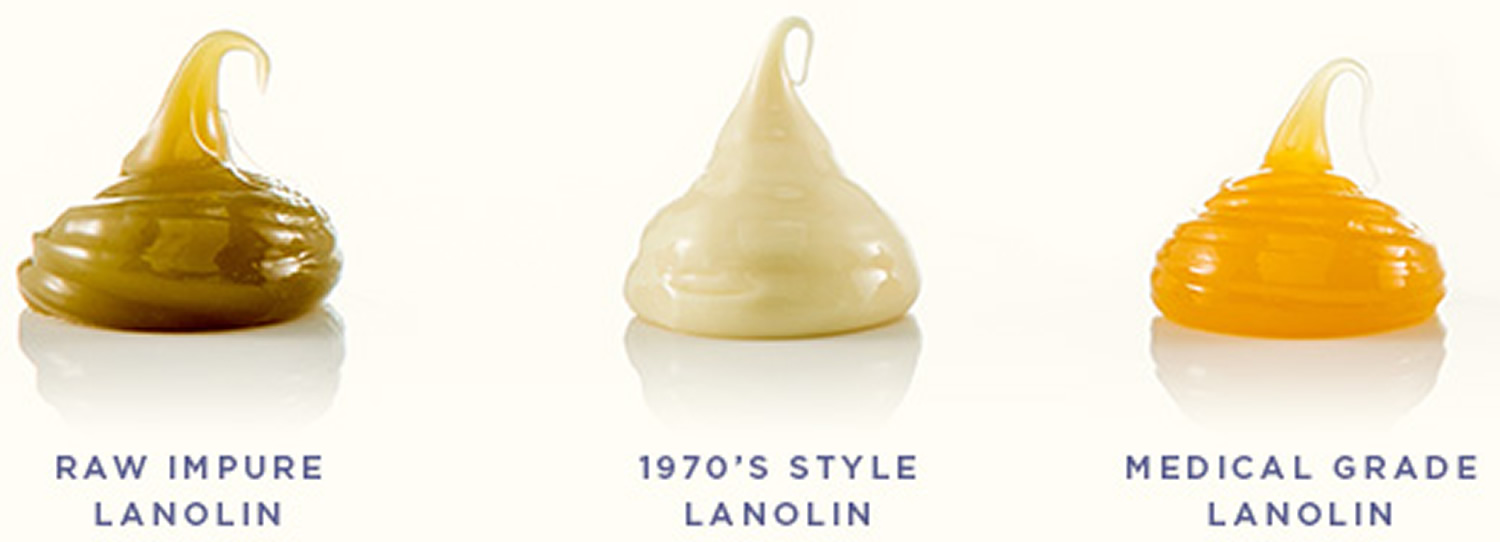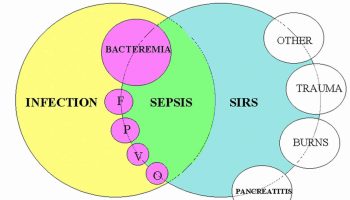Contents
What is lanolin
Lanolin also called wool wax or wool grease, is a waxy secretion produced by the sebaceous glands of sheep. Lanolin’s waterproofing property aids sheep in shedding water from their coats. Certain breeds of sheep produce large amounts of lanolin. The wool from one Merino sheep will produce about 250–300 ml of recoverable wool grease. Medical‐grade lanolin, such as Lansinoh® HPA®, is a single‐ingredient ointment processed to be free of alcohols, detergent and pesticide residues, color, and odor‐forming impurities. Lanolin is thought to provide a bacteriostatic, semi‐occlusive barrier to the skin that allows for moisture retention and enhances healing 1. Lanolin penetrates to the skin and facilitates the absorption of medicines. This composition is capable of absorbing up to 30% of water 2. Lanolin is commonly added to moisturize and soothe the skin. Lanolin easily absorbs through the skin and facilitates the absorption of medicinal chemicals when used as an ointment. In addition, lanolin may be used in lubricants, rust-preventative coatings, shoe polish, and other commercial products 3.
Crude lanolin constitutes about 5–25% of the weight of freshly shorn wool. Lanolin is extracted by washing the wool in hot water with a special wool scouring detergent to remove dirt, wool grease (crude lanolin), suint (sweat salts), and anything else stuck to the wool. The wool grease is continuously removed during this washing process by centrifuge separators, which concentrate it into a waxlike substance melting at approximately 38 °C (100 °F).
Lanolin is a good emulsifier; this means it binds well with water thus it is particularly useful in the manufacture of pharmaceutical and cosmetic formulations. Wool alcohols are found in many pharmaceutical preparations, cosmetics and toiletries. They also have some industrial uses.
Lanolin may be found in these products:
- Baby oil
- Eye care products
- Diaper rash products
- Hemorrhoid medicines
- Lotions and skin creams
- Medicated shampoos
- Makeup (lipstick, powder, foundation)
- Makeup removers
- Shaving creams
Other products may also contain lanolin.
Lanolin is a relatively common allergen and is often misunderstood as a wool allergy. However, allergy to a lanolin-containing product is difficult to pinpoint and often other products containing lanolin may be fine for use. Patch testing can be done if a lanolin allergy is suspected 3.
Typical allergic contact dermatitis reactions may occur in individuals allergic to wool alcohols. The rash is characteristically located on the face, hands and arms. There may be intense swelling and redness of the affected area within a few hours or the rash may appear after a day or two of the product being used.
Am I allergic to lanolin?
Patch testing using 30% lanolin in petrolatum is what is routinely used to test for sensitivity to lanolin. Although wool alcohols are the main sensitizers in lanolin they may not always be the cause of the sensitivity and patch testing with natural lanolin from several sources is also recommended.
The development of chemically modified lanolin may help to reduce the incidence of skin reactions to natural lanolin. However, there have been cases where patients have shown marked sensitivity to modified lanolin, yet not to natural lanolin. Dermatitis caused by modified lanolin may be missed if patch testing is confined to testing with wool alcohols and natural lanolin only.
Since lanolin is a natural product, its constituents vary depending on its source. Therefore an individual may be allergic to some lanolin-containing products but not to others. Self-testing a product for allergy to lanolin-containing products is possible but should be done only after first talking with your doctor. This should be done only with products that are designed to stay on the skin such as cosmetics and lotions. Apply a small amount (50 cent sized area) of the product to a small tender area of skin such as the bend of your arm or neck daily for 5 to 7 days. Examine the area each day and if no reaction occurs, it is unlikely you are allergic to it, although it may still act as an irritant. Products such as soaps, polishers and waxes should not be tested in this way.
What is lanolin used for?
Lanolin and its many derivatives are used extensively in both the personal care (e.g., cosmetics, facial cosmetics, lip products) and health care sectors such as topical liniments. Lanolin is also found in lubricants, rust-preventive coatings, shoe polish, and other commercial products 3.
| Pharmaceuticals | Cosmetics/toiletries | Industrial |
|
|
|
Lanolin is frequently used in protective baby skin treatment and for sore nipples in breastfeeding mothers 1.
Lanolin is used commercially in many industrial products ranging from rustproof coatings to lubricants. Some sailors use lanolin to create slippery surfaces on their propellers and stern gear to which barnacles cannot adhere. Commercial products (e.g. Lanocote) containing up to 85% lanolin are used to prevent corrosion in marine fasteners, especially when two different metals are in contact with each other and saltwater. The water-repellent properties make it valuable in many applications as a lubricant grease where corrosion would otherwise be a problem.
7-Dehydrocholesterol from lanolin is used as a raw material for producing vitamin D3 by irradiation with ultraviolet light 4.
Baseball players often use it to soften and break in their baseball gloves (shaving cream with lanolin is popularly used for this).
Anhydrous liquid lanolin, combined with parabens, has been used in trials as artificial tears to treat dry eye 5.
Anhydrous lanolin is also used as a lubricant for brass instrument tuning slides.
Lanolin can also be restored to woollen garments to make them water and dirt repellent, such as for cloth diaper covers.
Lanolin is also used in lip balm products such as Carmex. For some people, it can irritate the lips.
Lanolin is sometimes used by people on continuous positive airway pressure therapy to reduce irritation with masks, particular nasal pillow masks that can often create sore spots in the nostrils.
Lanolin is a popular additive to moustache wax, particularly ‘extra-firm’ varieties.
Lanolin is used as a primary lubricating component in aerosol-based brass lubricants in the ammunition reloading process. Mixed warm 1:12 with highly concentrated ethanol (usually 99%), the ethanol acts as a carrier which evaporates quickly after application, leaving a fine film of lanolin behind to prevent brass seizing in resizing dies.
Lanolin, when mixed with ingredients such as neatsfoot oil, beeswax and glycerol, is used in various leather treatments, for example in some saddle soaps and in leather care products.
Lanolin side effects
Lanolin poisoning occurs when someone swallows a product that contains lanolin.
Symptoms of lanolin poisoning include:
- Diarrhea
- Rash
- Swelling and redness of skin
- Vomiting
Symptoms of allergic reactions may include:
- Eye, lip, mouth, and throat swelling
- Rash
- Shortness of breath
Seek medical help right away. Do NOT make the person throw up unless poison control or a health care provider tells you to.
Your local poison control center can be reached directly by calling the national toll-free Poison Help hotline (1-800-222-1222) from anywhere in the United States. This national hotline number will let you talk to experts in poisoning. They will give you further instructions.
This is a free and confidential service. All local poison control centers in the United States use this national number. You should call if you have any questions about poisoning or poison prevention. It does NOT need to be an emergency. You can call for any reason, 24 hours a day, 7 days a week.
What to expect at the Emergency Room
Take the container to the hospital with you, if possible.
The provider will measure and monitor the person’s vital signs, including temperature, pulse, breathing rate, and blood pressure. Symptoms will be treated.
The person may receive:
- Blood and urine test
- Fluids through a vein (by IV)
- Laxative
- Medicines to treat symptoms
Lanolin poisoning prognosis
How well someone does depends on how much lanolin was swallowed and how quickly treatment is received. The faster medical help is given, the better the chance for recovery.
Medical-grade lanolin is not very poisonous. Nonmedical grade lanolin sometimes causes a minor skin rash. Lanolin is similar to wax, so eating large amounts of it can cause a blockage in the intestines. Recovery is very likely.
Lanolin allergy
Wool alcohols are the principle component of lanolin in which allergens are found. Lanolin is a natural product obtained from the fleece of sheep. Sebum is extracted from the wool, cleaned and refined to produce anhydrous lanolin. This comprises 3 parts, wool alcohols, fatty alcohols and fatty acids. Currently the wool alcohols are considered the main sensitizers in lanolin but whether they are the sole sensitizers, needs further investigation. Nowadays there is also chemically modified lanolin that may be less sensitizing than natural lanolin.
Wool alcohols, wool fat, anhydrous lanolin, lanolin alcohol, wool wax and wool grease are just some of the terms used interchangeably with lanolin. In this article we will use wool alcohols, as it is this fraction of lanolin that is the main cause of contact allergies.
In a study involving 276 moisturizers 3, lanolin, a component of moisturizer used to soothe the skin, was the ninth most common allergen and was identified in 27 (10%) of 276 moisturizers. Between 1998 and 2000, the North American Contact Dermatitis Group discovered that 2.4 percent of their patients were allergic to lanolin alcohol.13 Although lanolin alcohol is believed to be the main sensitizer, lanolin is derived from the fleece of sheep and comprises hundreds of different chemicals, making it difficult to isolate the contact allergens. Additionally, lanolin-sensitive patients may tolerate one product containing lanolin but not another 6. Furthermore, the true prevalence of positive reactions is unknown since reactions are often not reproducible and false positives and negatives commonly occur 7. Therefore, patch testing with the patient’s own product may be of value. Patch testing for lanolin allergy is done with either wool alcohol or a mixture of lanolin alcohol and mineral alcohol (containing wool alcohol from the hydrolysis of wool fat). Of note, occasional cross reactants to lanolin include fatty alcohols such as stearyl and cetyl alcohol 8.
Similar to paraben sensitivity, reactions to lanolin more frequently occur on compromised skin, yet lanolin is generally safe when added to cosmetics extensively used in the population on noncompromised skin 3. Furthermore, patients sensitized to lanolin as a result of topical therapeutic agents may tolerate lanolin-containing cosmetics 7. Case studies have been published demonstrating that some patients who patch test positive to lanolin are able to tolerate lanolin-containing cosmetics when used on normal skin 9.
Management of dermatitis caused by lanolin allergy
Once the dermatitis appears on the skin, the first thing to do is to remove the source. In most instances this would entail stopping the use of all products that contain lanolin.
Standard treatment with emollients and topical steroids must not contain lanolin.
What should I do to avoid wool alcohol allergy?
If you have wool alcohol allergy the best way to avoid any problems is by avoiding all products that contain wool alcohols. Check all product labels for the list of ingredients and do not use if they contain wool alcohols or any of the other names for wool alcohols. If you are unsure, ask your pharmacist for advice and a suitable alternative.
Alert your doctor to the fact that you have an allergy to wool alcohols. This is particularly important as some topical medications that your doctor may want to prescribe to you contain wool alcohols.
Your dermatologist may have further specific advice, particularly if you are highly sensitive to wool alcohols.
Wool alcohol is also known by several other names. These include:
- Adeps lanae anhydrous
- Aloholes lanae
- Amerchol
- Anhydrous lanolin
- Lanolin
- Wool fat
- Wool grease
- Wool wax
Avoid all of these. At work, request a material safety data sheet to help identify potential sources of exposure.
- Dennis CL, Jackson K, Watson J. Interventions for treating painful nipples among breastfeeding women. Cochrane Database of Systematic Reviews 2014, Issue 12. Art. No.: CD007366. DOI: 10.1002/14651858.CD007366.pub2[↩][↩]
- Ebadi M. Pharmacodynamic basis of herbal medicine. United States: CRC Press. 2001[↩]
- Zirwas MJ, Stechschulte SA. Moisturizer Allergy: Diagnosis and Management. Zirwas MJ, ed. The Journal of Clinical and Aesthetic Dermatology. 2008;1(4):38-44. https://www.ncbi.nlm.nih.gov/pmc/articles/PMC3016930/[↩][↩][↩][↩][↩]
- Holick, M. F (2007). “Vitamin D deficiency”. New England Journal of Medicine. 357 (3): 266–81. doi:10.1056/NEJMra070553[↩]
- Pucker AD, Ng SM, Nichols JJ. Over the counter (OTC) artificial tear drops for dry eye syndrome. The Cochrane database of systematic reviews. 2016;2:CD009729. doi:10.1002/14651858.CD009729.pub2. https://www.ncbi.nlm.nih.gov/pmc/articles/PMC5045033/[↩]
- Ortiz KJ, Yiannias JA. Contact dermatitis to cosmetics, fragrances, and botanicals. Dermatol Ther. 2004;17(3):264–271[↩]
- Zachariae C, Lerbaek A, McNamee PM, et al. An evaluation of dose/unit area and time as key factors influencing the elicitation capacity of methylchloroisothiazolinone/ methylisothiazolinone (MCI/MI) in MCI/MI-allergic patients. Contact Dermatitis. 2006;55(3):160–166.[↩][↩]
- Scheman A, Jacob S, Zirwas M, et al. Contact allergy: alternatives for the 2007 North American Contact Dermatitis Group (NACDG) standard screening tray. Dis Mon. 2008;54(1-2):7–156.[↩]
- Orton DI, Wilkinson JD. Cosmetic allergy: incidence, diagnosis, and management. Am J Clin Dermatol. 2004;5(5):327–337.[↩]





